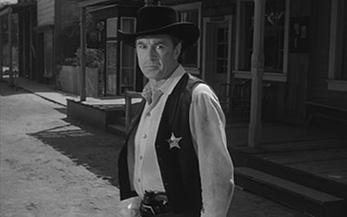|
|
Classic Movie Review: High NoonBy Clint ChirpichJanuary 21, 2016
Kane has two options - stay and fight Miller and his gang or leave town as planned. Of course, since Kane is an honorable and proud man, he chooses to stay and stand up against the outlaws. Fowler is upset, with good cause, and threatens to leave with or without him, but Kane doesn't change his mind. He can't bear the thought of Miller running amok through Hadleyville. For most of the film, Kane proceeds to look for help from the townspeople, hoping to deputize as many as possible in order to fight off Miller when the time comes. He runs into problems, though, as most of the people aren't interested in helping him, for various reasons. High Noon plays out almost in real time. Kane learns of Miller's impending arrival at 10:40 a.m., so he has an hour and 20 minutes to prepare, and the film runs about 65 minutes before the train arrives and Miller is revealed. This film-making choice is interesting and effective as it results in the tension and suspense being ratcheted up each time Kane glances at a clock or at his pocket watch. The audience knows that something terrible is going to happen when the train comes in, and we get to experience the lapse of time right alongside Kane. There's not a lot of traditional action in High Noon, or at least certainly nowhere near as much as most westerns. When it comes, though, the action is handled extremely well. There's one fist fight and then the climatic shootout. Both scenes are photographed and choreographed in an excellent fashion - they pull you in and keep you engaged. What really intrigued me, though, was the psychological action that fills most of the film. As I said before, Kane spends most of the time speaking with people, trying to get them to join him. Each conversation is like a mental brawl, with Kane fighting for his life. It's excellent stuff, thanks to the writing and performances.
[ View other Classic Movie Reviews ]
[ View other articles by Clint Chirpich ]
[ Email this column ]
|

|
|
|

|
Friday, November 1, 2024
© 2024 Box Office Prophets, a division of One Of Us, Inc.


